You don’t have to be a professional plumber to replace or install a toilet in your home. However, one small component often confuses homeowners — the offset toilet flange wax ring. It may look simple, but it plays a crucial role in ensuring your toilet remains leak-free, stable, and odorless for years.
In this ultimate guide, we’ll explain what an offset toilet flange wax ring is, why it’s different from a regular wax ring, and how you can install it properly — even if you’ve never done plumbing work before.
What Is an Offset Toilet Flange?
A toilet flange, also called a closet flange, connects your toilet to the floor and to the main drainpipe. It keeps the toilet stable and channels waste into the drain.
A standard flange sits directly over the drain opening, but sometimes that exact alignment doesn’t fit your bathroom layout. Maybe the toilet is too close to the wall, or a new tile layer changed the height and alignment.
That’s when you need an offset toilet flange.
An offset flange is designed with a curved or angled outlet that allows the toilet to be shifted ½ inch to 2 inches in any direction — forward, backward, or sideways — without moving the actual drain line. This gives flexibility during renovation or when working in tight spaces.
Why Offset Flanges Are Important
- They fix misalignment when the toilet hole doesn’t sit directly over the drain.
- They allow you to reposition your toilet without breaking the floor or adjusting the plumbing.
- Perfect for small bathrooms or areas where every inch matters.
For example, if your new vanity or shower takes up extra space and your toilet is now too close to the wall, you can use an offset flange to shift the toilet slightly forward — avoiding costly re-plumbing.
What Is a Wax Ring (and Why It Matters)?
The wax ring is a soft, moldable seal made of beeswax or petroleum wax that sits between the toilet base and the flange. It creates a watertight and airtight barrier that prevents water and sewer gases from escaping.
Whenever you flush the toilet, water rushes through the trapway and into the flange. Without a proper wax ring seal, wastewater could leak onto your bathroom floor, and unpleasant sewer odors could enter your home.
A wax ring ensures:
- No leakage between the toilet and drainpipe.
- Odor control by sealing sewer gases.
- Secure mounting of the toilet base.
Over time, however, wax rings can compress, dry out, or deform — especially if the toilet wobbles or the floor shifts. That’s when replacement becomes necessary.
What Is an Offset Toilet Flange Wax Ring?
When using an offset flange, the angle of connection between the toilet and the drain is slightly different from a straight-down connection. A regular wax ring may not seal that curve properly.
An offset toilet flange wax ring is specially designed to maintain a tight seal on angled or curved offsets. It adapts to the non-centered position and ensures that the seal remains firm, leak-proof, and odor-proof.
In simple terms, it’s a modified version of the traditional wax ring — designed for flexibility and stronger sealing performance.
Offset Toilet Flange vs. Regular Flange: Detailed Comparison
| Feature | Regular Toilet Flange | Offset Toilet Flange |
|---|---|---|
| Shape | Straight and centered | Curved or offset to one side |
| Movement | Fixed in one position | Allows repositioning of the toilet |
| Best Use | Perfectly aligned bathrooms | Bathrooms with alignment or spacing issues |
| Installation Difficulty | Easy | Slightly more complex but flexible |
| Price Range | Cheaper | Slightly more expensive due to design |
Offset flanges are a lifesaver for older homes, remodels, or DIY installations where the original plumbing setup can’t be changed easily.
Offset Wax Ring vs. Regular Wax Ring
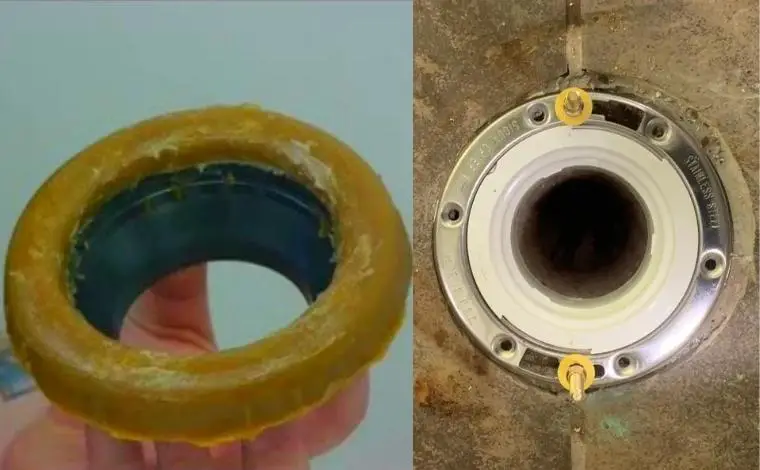
While both types of wax rings serve the same purpose (to seal the toilet to the flange), the offset wax ring offers some unique benefits:
- Shape Adaptability: It can handle angled or offset toilet flanges better than flat rings.
- Stronger Seal: It prevents leaks even when the flange isn’t perfectly level.
- Durability: Offset wax rings are thicker and provide a long-lasting seal.
- Odor-proof Design: They stop sewer gas more effectively thanks to tighter compression.
So, if your toilet uses an offset flange, you must use an offset-compatible wax ring — a regular one won’t work correctly.
Benefits of Using an Offset Toilet Flange Wax Ring
1. Perfect for Misaligned Toilets
If your toilet doesn’t align with the drain hole, an offset wax ring bridges that small gap easily. You can move your toilet slightly without leaks.
2. Easy Installation
Even a beginner DIYer can install it with basic tools. You don’t need professional plumbing skills — just patience and precision.
3. Long-Term Leak Prevention
The thick wax layer and curved base create a seal strong enough to last for 20–30 years under normal use.
4. Odor Control
No one likes a smelly bathroom. The wax ring keeps all gases locked inside the drainpipe.
5. Works with All Floor Types
Offset wax rings are compatible with both wooden and concrete subfloors. Depending on your floor type, you can choose a solid (for concrete) or perforated (for wood) flange design.
When Do You Need an Offset Toilet Flange?
You should use an offset flange (and wax ring) when:
- The existing drain is not centered under the toilet.
- The floor was remodeled or tiled, changing toilet position.
- The toilet sits too close to a wall or door.
- The flange height is uneven after renovation.
For instance, many homeowners find that after installing thick tiles, the toilet no longer sits evenly — the offset flange helps correct that height or alignment easily.
Tools and Materials You’ll Need
Before starting, gather the following:
- Adjustable wrench
- Screwdriver
- New offset toilet flange
- Offset wax ring (double-thick recommended)
- Plumber’s putty or silicone caulk
- Drill (for concrete floors)
- Replacement bolts and nuts
- Putty knife
- Cleaning rags
Having all the tools ready will make the process smoother and prevent interruptions.
How to Install an Offset Toilet Flange Wax Ring (Step-by-Step Guide)
Installing a new offset flange and wax ring isn’t difficult if you follow each step carefully.
Step 1: Turn Off the Water Supply
Locate the shut-off valve behind your toilet and turn it clockwise to stop the water flow. Flush the toilet to empty both the tank and bowl completely.
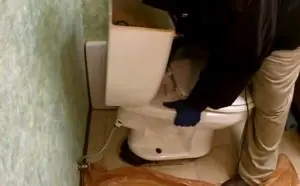
Step 2: Remove the Existing Toilet
Use a wrench to remove the nuts holding the toilet to the floor. Gently rock the toilet from side to side to break the old wax seal. Lift it carefully and place it on a towel.
If your toilet is heavy, ask someone for help — porcelain can crack if dropped.
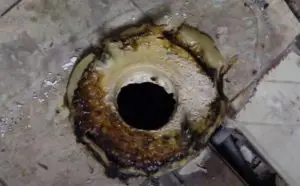 Step 3: Clean the Old Wax and Drainpipe
Step 3: Clean the Old Wax and Drainpipe
Scrape away the old wax ring using a putty knife. Clean the drainpipe opening thoroughly. You can use a degreaser or warm soapy water to ensure there’s no residue left.
This step is essential — leftover wax or debris can prevent the new ring from sealing properly.
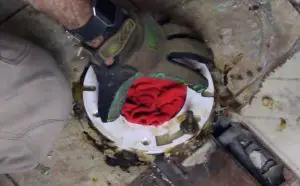 Step 4: Inspect and Prepare the Offset Flange
Step 4: Inspect and Prepare the Offset Flange
Place the new offset flange over the drainpipe. Adjust its direction based on where you want to move the toilet (forward, backward, or sideways).
Once positioned, secure it with screws to the floor.
If you’re working with concrete, use a drill to make holes and insert anchors before tightening screws.
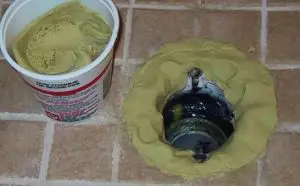 Step 5: Apply Plumber’s Putty or Caulk
Step 5: Apply Plumber’s Putty or Caulk
Apply a ring of plumber’s putty or silicone around the base of the flange to create an additional moisture barrier. This prevents water from seeping under the floor in case of minor leaks.
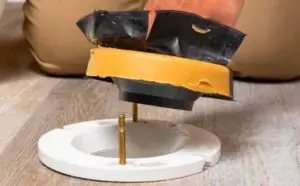 Step 6: Position the Wax Ring
Step 6: Position the Wax Ring
Now, take the offset wax ring and press it gently onto the flange. Make sure the offset section matches the flange’s curve. If your toilet sits higher due to tiles, use a double-thick wax ring.
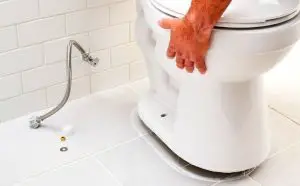 Step 7: Set the Toilet
Step 7: Set the Toilet
Carefully lift the toilet and align the bolt holes with the flange bolts. Lower the toilet straight down onto the wax ring.
Rock it slightly in both directions to help the wax spread evenly and form a solid seal. Avoid twisting too much — that can break the seal.
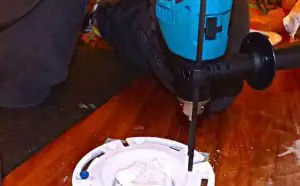 Step 8: Secure the Toilet
Step 8: Secure the Toilet
Install the washers and nuts on the bolts and tighten them alternately. Don’t overtighten — porcelain cracks easily. The toilet should feel firm and not wobble.
Step 9: Reconnect the Water Supply
Reattach the water line to the tank and turn the shut-off valve counterclockwise to restore water flow. Let the tank fill and flush several times to check for leaks.
Step 10: Final Inspection
Check the base of the toilet for any water seepage. Sit on it gently to confirm stability. If everything feels solid and dry — congratulations, your installation is complete!
Pro Tips for Installing Offset Toilet Flanges
- Always replace the wax ring when reinstalling or moving a toilet — never reuse an old one.
- Dry-fit first. Before applying wax, place the toilet once to check the alignment.
- Use stainless-steel bolts for durability, especially in humid bathrooms.
- Level the toilet. Use a small level tool to ensure it doesn’t tilt forward or sideways.
- Seal the base. Once installed, run a thin bead of silicone caulk around the toilet base to prevent water from seeping underneath.
Common Mistakes to Avoid
- Incorrect Offset Direction: Always check which way the flange is turned before securing it.
- Using Too Thin a Wax Ring: If your floor is uneven, a regular wax ring may not compress enough — use a thicker one.
- Skipping Cleaning: Dirt or old wax residue can ruin your new seal.
- Over-tightening Bolts: Can crack the toilet base and cause leaks later.
- Not Testing for Leaks: Always flush several times before calling it done.
Maintenance Tips for Longevity
- Inspect the base of your toilet once every few months for moisture or wobbling.
- If you ever notice a bad smell or water pooling around the base, replace the wax ring immediately.
- Avoid using harsh chemicals near the wax ring area — they can degrade the seal over time.
- Always replace the wax ring during bathroom renovations or when installing new flooring.
Alternatives to Wax Rings
While wax rings have been around for decades, there are now wax-free toilet seals available. These use rubber or foam to create a reusable, mess-free seal.
Advantages of Wax-Free Seals:
- Easier to install and reposition.
- Don’t melt or deform in heat.
- Reusable if you need to move the toilet again.
However, traditional wax rings still offer the best long-term reliability, especially with offset flanges where flexibility and compression matter most.
Safety Precautions
- Always wear gloves when handling old wax — it can contain bacteria.
- If your bathroom has a concrete subfloor, wear protective eyewear when drilling.
- Keep a towel handy to clean any residual water during the process.
- Ensure the room is well-ventilated while using putty or caulk.
Environmental Tip
When disposing of old wax rings, never flush them or throw them directly into drains. Wrap them in paper or plastic and dispose of them with household waste. Old wax is not biodegradable but can be safely discarded with minimal impact if sealed properly.
Troubleshooting Common Issues
1. Toilet Rocks After Installation
→ The flange might not be level or the wax ring too thin. Use flange spacers or replace with a double-thick ring.
2. Water Leaks at the Base
→ The wax ring didn’t seal correctly. Remove and reinstall with a new one.
3. Bad Odor Despite New Installation
→ Check if the flange screws are tightened and the wax ring compressed properly; a small air gap may remain.
4. Offset Flange Too High or Too Low
→ Use flange extenders or cut the flange height to match the floor level.
Conclusion
An offset toilet flange wax ring may seem like a small, insignificant part of your toilet setup — but it’s the key to a watertight, odor-free, and stable installation.
It allows you to reposition your toilet without expensive plumbing work, ensures perfect alignment, and provides long-term protection from leaks and odors.
With the detailed installation steps and practical tips in this guide, you can confidently handle the job yourself — saving both money and time while improving your bathroom’s hygiene and durability.
So, whether you’re doing a DIY toilet replacement, a bathroom remodel, or just fixing a leak — the offset toilet flange wax ring is your best friend in achieving a professional, lasting result.
FAQs
Q1: Why should I use an offset toilet flange instead of a regular one?
Because an offset flange lets you reposition your toilet up to 2 inches in any direction without moving the drain line — perfect for small or remodeled bathrooms.
Q2: How often should I replace a wax ring?
Wax rings usually last 20–30 years, but replace them anytime the toilet is removed or if you notice water leakage or bad odor.
Q3: What’s the difference between a single and double-thick wax ring?
A double-thick ring is ideal for uneven floors or raised tile surfaces, providing extra compression and a stronger seal.
Q4: Can I reuse a wax ring?
No. Once compressed, wax rings cannot reseal properly. Always install a new one.
Q5: Are offset wax rings universal?
Most are compatible with both 3-inch and 4-inch drain openings, but always check the packaging before purchase.
Q6: Can I use plumber’s putty instead of a wax ring?
No. Putty cannot provide the same watertight, flexible seal as wax. It’s meant only to supplement the seal around the flange base.
Q7: Do I need a professional plumber?
Not necessarily. If you follow the step-by-step guide carefully, most homeowners can complete this installation within 1–2 hours.
Hi, this is Robert Crossan, the owner of this website, has 17 years of experience in the installation, maintenance, and repair of toilets and plumbing systems. After completing the Level 2 Basic Plumbing course in 2005, I started working in both domestic and commercial buildings as a professional plumber. So I can figure out the core difference between different toilet models and brands. It also helped me monitor their work performance and setbacks.